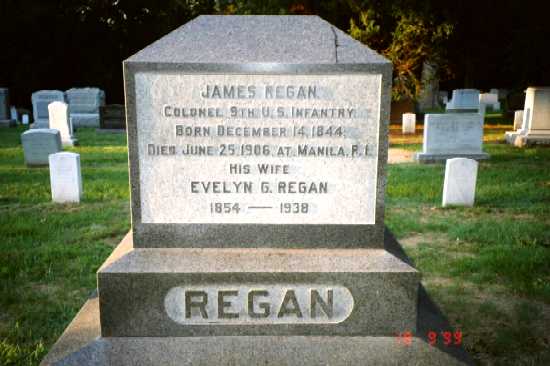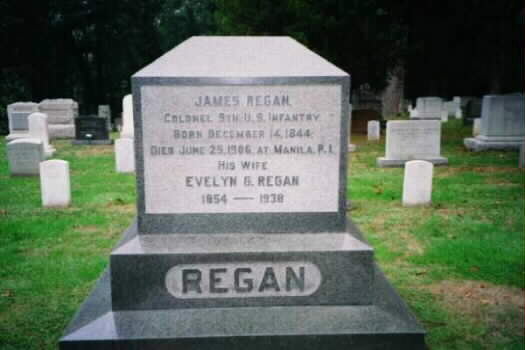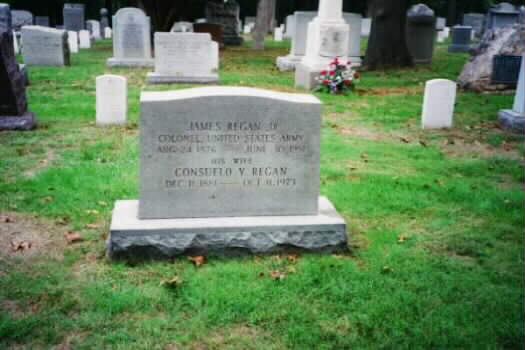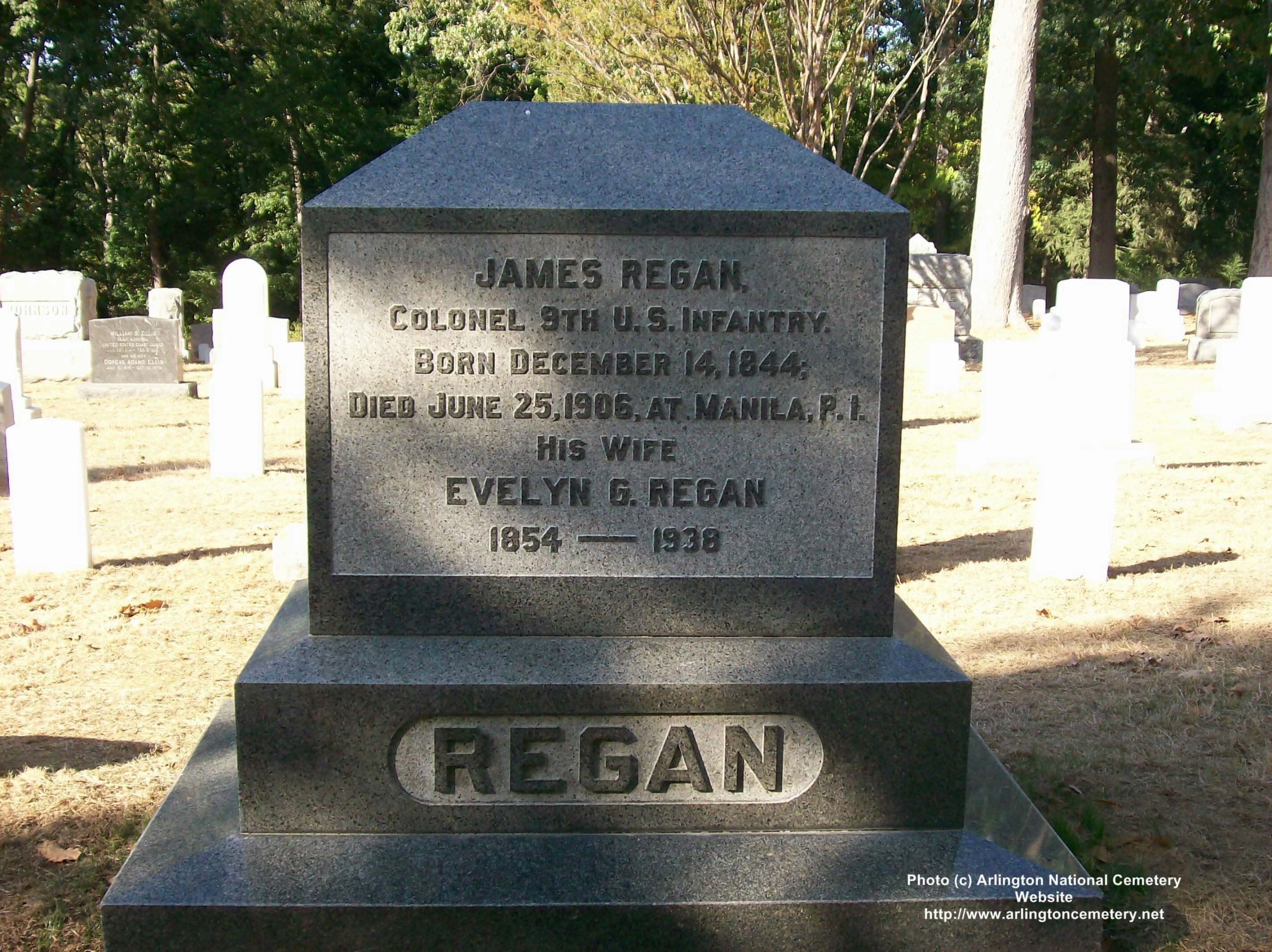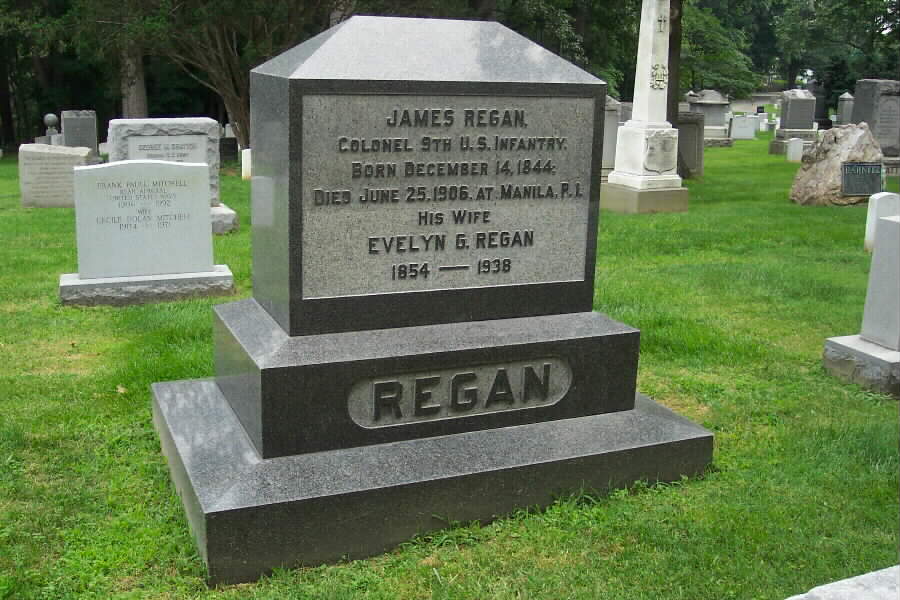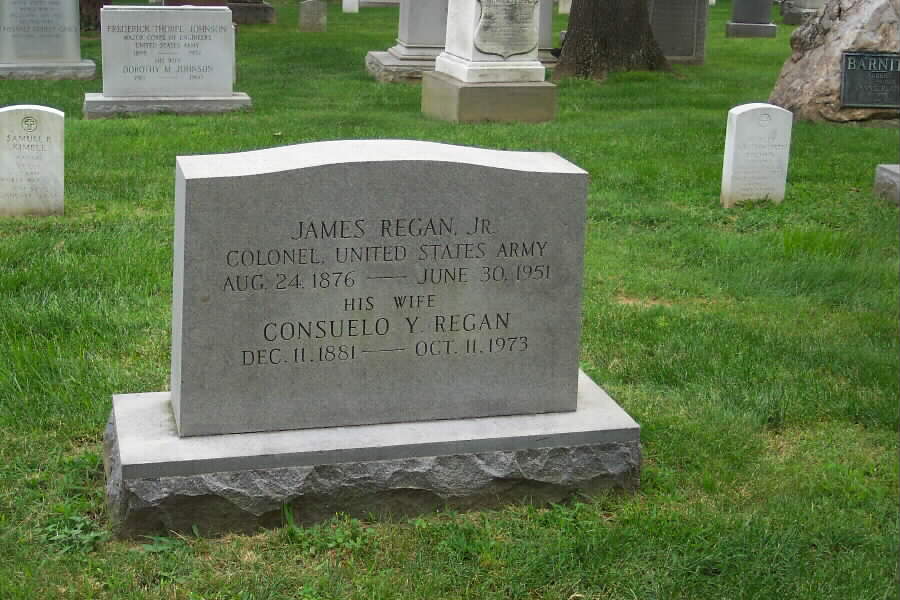The following information was provided by the Colonel's Great-Granddaughter, Consuelo Y. Regan-Alexander, as a remembrance to him. Thanks, Connie!
G.O. No. 8
HEADQUARTERS NINTH U. S. INFANTRY
Cuartel de Espana, Manila, P.I.
June 28, 1906
General Orders
No.8
The sad duty devolves upon the Regimental Commander of announcing to the Regiment the death of its Colonel, James Regan. Colonel Regan died at about 2:00 o'clock A.M., June 25, 1906, at Cuartel de Espana, Manila. On the previous evening he was apparently well; death came to him while sleeping. Thus died Regan, one of the most modest, tenderest and bravest soldiers; on duty to the last with the Regiment he had served so long and loved so well.
He had more than two years to serve before reaching the age limit, yet he had served longer than any office upon the active list of the Army; having entered the service when but thirteen years and six months of age.
Since his assignment to the Regiment as a First Lieutenant in 1870, practically all his service had been with it. He was a firm believer in the principle that a line officer belonged with his colors; and excepting about two years when he was unfit for field work, as a result of wounds, he served with his command. He served in many Indian campaigns on the frontier from 1858 until such service practically ceased. He was recommended for the brevet of Major for gallantry in action at the battle of San Juan and the siege of Santiago de Cuba, and for a Medal of Honor and brevet of Lieutenant Colonel for coolness, courage and heroic exposure under heavy fire, until severely wounded, at the Battle of Tientsin, China. As a Major, he commanded the Regiment en route to and in the Philippines from March 24th to June 29th, 1899, and afterward the Second Battalion in the campaigns in Luzon and China, until twice severely wounded, which necessitated his being sent to the United States. From the effect of one of these wounds he never fully recovered. He became Colonel of the Regiment July 29, 1903, after having served in it through all grades from First Lieutenant.
He was of a kind disposition and rarely did he utter a harsh word to either officer or man. His life may well be taken as a model for the American soldier. As the Most Reverend J. J. Harty, Archbishop of Manila, stated in his address at the funeral services, “He won the confidence of his superiors and the love and respect of his officers and men.” The Regiment has lost its best soldier and the Army a man not easily replaced.
The usual badge of mourning will be worn for thirty days. The following is a brief summary of his record:
Born in New York City, December 14, 1844. Field Musician, Company H, 2nd Infantry, June 1, 1858 to June 1, 1863. Musician and Sergeant, Company B, General Service, March 8, 1864 to December 31, 1866. Second Lieutenant, 18th Infantry, December 1, 1865; First Lieutenant, 18th Infantry, August 12, 1867; unassigned April 26, 1869; assigned to the 9th Infantry, December 15, 1870. Captain, 9th Infantry, June 15, 1887; Major, 9th Infantry, March 2, 1899; Lieutenant Colonel, 1st Infantry, July 26, 1901; transferred to the 9th Infantry, April 11, 1902; Colonel, 9th Infantry, July 29, 1903.
In the field against Indians at Kansas, 1861, and near Fort Sedgwick, Colorado, 1867. Commanded escort bearing dispatches to Fort Phil Kearney, March 1868. At Governor's Island, N.Y., June 1869 to February 1871. Joined 9th Infantry, June 6, 1871. Yellowstone Expedition, May 20 to October 9, 1873. Regimental Quartermaster, June 22, 1879 to September 30, 1886. Expedition to Santiago de Cuba, June 1898. Battle of San Juan and siege of Santiago de Cuba. Expedition to Philippine Islands, March 1899. Advance from San Ferrando: battles of Calulut, August 9, Porao, September 28, 1899 and night attacks at Angeles, October 11-16, 1899. China Relief Expedition, June 1900: battle of Tientsin, July 13, 1900. Absent sick, wounded, and on recruiting duty, New York, to August 1903. Assumed command of Regiment as Colonel, August 17, 1903, at Madison Barracks, N.Y. In Philippine Islands since June 1, 1905.
BY ORDER OF LIEUTENANT COLONEL ROBERTSON:
E. V. Bookmiller
Captain and Adjutant, 9th InfantryOFFICIAL
James Regan of New York.
Army Musician, Company H, 2nd Infantry, 1 June 1858 to 1 June 1863
Musician and Sergeant, 8 Mar 1864 to 31 December 1866
Second Lieutenant, 18th U.S. Infantry, 1 December 1866
First Lieutenant, 12 August 1867
Unassigned 26 April 1869
Assigned to 9th U.S. Infantry, 15 December 1870
Regimental Quartermaster, 22 June 1879 to 1 October 1886
Captain, 15 June 1887
Major, 2 Mar 1899
Lieutenant Colonel, 1st U.S. Infantry, 26 July 1901
Transferred to the 9th U.S. Infantry, 11 April 1902
Colonel Regan was subsequently buried in Section 1 of Arlington National Cemetery. His wife, Evelyn G. Regan (1854-1938) is buried with him. His son, James Regan, Jr., Colonel, United States Army, is buried nearby.REGAN, EVELYN G W/O JAMES
- DATE OF DEATH: 01/14/1938
- DATE OF INTERMENT: 01/17/1938
- BURIED AT: SECTION WEST SITE 111-B
- ARLINGTON NATIONAL CEMETERY
- WIFE OF JAMES REGAN – COL 9TH US INF
REGAN, JAMES
COL 9 US INF
- VETERAN SERVICE DATES: Unknown
- DATE OF DEATH: 06/25/1906
- DATE OF INTERMENT: Unknown
- BURIED AT: SECTION B SITE 111
- ARLINGTON NATIONAL CEMETERY
Michael Robert Patterson was born in Arlington and is the son of a former officer of the US Army. So it was no wonder that sooner or later his interests drew him to American history and especially to American military history. Many of his articles can be found on renowned portals like the New York Times, Washingtonpost or Wikipedia.
Reviewed by: Michael Howard

